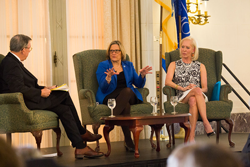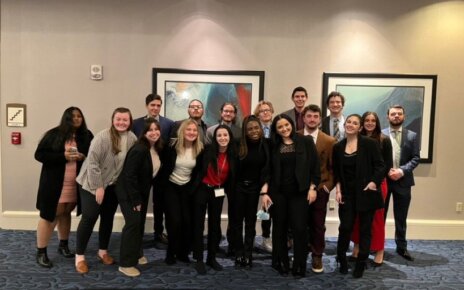The 10th Annual Future of the Ocean Symposium and Champions of the Ocean Awards Luncheon honored Dr. Kathryn Sullivan and Wendy Schmidt, NJ natives and distinguished pioneers of the environmental intelligence industry.
Hosted by the Urban Coast Institute (UCI), an extension of the University’s Marine and Environmental Biology departments, this event was a timely recognition of how coastal communities like Monmouth County have progressed since the devastation of Hurricane Sandy approximately two years ago.
President Paul Brown opened the symposium on Thursday, Oct. 30 in Wilson Hall by recognizing the University’s distinctive location on the shoreline, explaining that he considers Monmouth to be a “coastal campus.” As such, we are in the unique position of making a considerable difference in the environment around us, as well as honoring leaders of the environmental movement.
It also demonstrates how we as citizens of the shore can further protect our environment. Proceeds of this event helped support a $5 million Marine Science and Policy Initiative Challenge Grant, which will have a transformative impact on the breadth and depth of the University’s marine projects and programs.
Tony MacDonald, founding director of the UCI, described this year’s honorees as “inspiring Jersey girls [that will] launch us into our next decade.” He said, “They’re really looking over the horizon and deep under the sea, and can expand our vision about what is possible in the future.”
Established in 2005, The Champion of the Ocean Award was created to honor individuals who have undertaken actions and demonstrated sustained leadership, advancing a future in which coasts and oceans are clean, safe, sustainable, and preserved for the benefit and enjoyment of future generations.
Previous winners of the National Ocean Champion Award include: Admiral Thad Allen, environmental scientist, advocate Professor Jesse Huntley Ausubel, and ocean scientist and advocate Jean-Michael Cousteau, among others.
Sullivan, the first honoree, is a Patterson, NJ native currently serving as Acting Under Secretary of Commerce for Oceans and Atmosphere, as well as Acting Administrator of National Oceanic and Atmospheric Administration (NOAA). Sullivan is also a renowned astronaut, being one of the first six women selected to join the NASA astronaut corps in 1978, and the first American woman to walk in space.
Former University President Paul Gaffney, the event’s moderator, notes that Sullivan “aims to understand, measure, and predict the ocean that surrounds us and the atmosphere above us.”
The event also honored environmental activist Schmidt, president of The Schmidt Family Foundation and the co-founder the Schmidt Ocean Institute (SOI) at Stanford University. Schmidt works to advance the development of renewable energy and wiser use of oceans and other natural resources. The foundation supports more than 150 nonprofit organizations in program areas including climate energy, ecological agriculture, human rights, and our maritime connection.
Sullivan was first to the podium, and her goal was to define environmental intelligence and explain its role in fostering resilience among coastal communities. Sullivan first explained that Sandy, while devastating, was largely instrumental in moving the environmental discussion forward. She said, “Sandy in many respects helped turn the needle and spark conversation on a broader scale across the country, from simple repair to a broader concept of resilience.”
This was seen in coastal communities like Hoboken, which Sullivan described as being underwater for weeks. Sullivan studied the town’s emergency management systems, and saw not only how they built back, but how “[one can] move forward towards future conditions and a more resilient community.”
Sullivan further explained that these extreme events are not the only reason to invest in environmental research. Our coastal zone currently faces many threats, such as climate, habitat modification, and pollution. 39 percent of the U.S. population now lives in coastal counties, where the economy is currently estimated to reach $6.6 trillion. These factors make the resilience of our neighboring environment imperative.
Sullivan said, “[Resilience] is not something you can buy off the shelves, or something you can install or spray over a community. It’s something that must be built from within, by the community itself. And that is really what we’ve been seeing many shining examples of in this area over the last few years.”
Sullivan said this is where environmental intelligence becomes important. Sullivan defines environmental intelligence as, “timely, actionable, reliable, action-oriented information that can inform decisions.” She said that this information helps to provide “insight as well as foresight, the ability to look ahead, think ahead, imagine and consider alternative scenarios that we might face as a consequence of our actions.”
NOAA, can be looked at as an environmental intelligence agency in that it tailors information to help people make decisions as the head of a community, head of a business, or head of a household, according to Sullivan. NOAA focuses its research on three aspects of resilience (societal, ecological, and economic) and aims to “keep the pulse of the Earth,” according to NOAA.gov.
NOAA’s efforts encouraged a positive change in our community. One such development was the embracing of green infrastructure, or the natural environments that help to protect our shorelines. While NOAA has carried this movement forward, Sullivan argues that there is still much more to be done.
Sullivan said, “We do need more science to really drive this conversation and carry it forward. We need clearer research on which natural defenses work and [which scenarios they benefit]. We need better methods to attach value to these natural environments and to all of the assets that they can bring to a community.”
Despite this, Sullivan believes that the University is on the correct course. She referred to Monmouth as a “central player in the mid-Atlantic region,” developing new technologies and collecting vital information through the UCI. Sullivan said, “I have not seen any where else an institute that brings so many of the needed threads together to weave a fabric of resilience: science, law, policy, business, economics, and elected government.”
Further, Sullivan said that if anywhere a positive change can take place, “it will be here, it will be partly because of the spur that Sandy provided, but it will be because of the way the UCI are working across society to bring information and insights forward.”
“The Urban Coast Institute is a unique aspect to the marine science program that makes it stand out among other universities,” said Amanda Billotti, a senior studying marine and environmental biology and policy. Bilotti believes that by hosting events like the 10th Annual Future of the Ocean Symposium, students are provided an experience of real life career applications.
Schmidt then took over the podium, agreeing with Sullivan that our planet is quite dynamic, and that we are all ready for a “big wake up call.”
“At The Schmidt Foundation,” she explained, “[the aim is to] provide progress support and investment for people working to re-imagine a wiser use of energy and natural resources in this century, to redesign our food, water, and transportation systems so that they are healthy and sustainable.”
Schmidt’s colorful speech highlighted the extent to which mankind has attempted to vilify the ocean, describing it with terms like “dark depths” and “abyss,” filling it with “monsters with tentacles and razor-sharp teeth.” According to Schmidt, we’ve let these definitions satisfy our curiosity, using the second half of the 20th century to explore outer space and technology as opposed to the vast waters surrounding us.
Similarly, Schmidt explains how we have gotten carried away with, unaware of (or perhaps unfazed by) the damage our wastefulness is causing our planet. Schmidt said, “Our 20th century industrial model is failing to account for the waste, now threatening our oceans and lands, and government policy has failed to account for the cost of carbonations.”
Despite these alarming facts, Schmidt is optimistic for the future. She believes that our planet’s renewable resources, the growing awareness of the environmental impact and human footprint, and humanity’s access to information and can combine to make an extraordinary opportunity for the human race in this century. “We can remake the way we [build] things using resources more wisely, and we can create an industrial economy that is regenerative instead of wasteful,” she said.
According to Schmidt, this process starts when we examine our small role in a much bigger network “We need to figure out where we really fit in to the living systems and how we’re going to survive as a species.”
When establishing The Schmidt Foundation, the honoree noted that she and her husband were responding to the fact that we as a country knew more about the surface of Mars than we do about our own oceans.
She explained that the organization’s mobile computing and mapping capabilities would challenge the traditional research model and accelerate the pace at which we understand our planet.
She said, “What’s important is that it is recognizing the need for knowledge to be shared rapidly to replace the system-disrupting industrial designs of the past century before they irreversibly change the fertile lands and seas.”
Schmidt suggests that we move forward by “rapidly [reducing] burning fossil fuels and [replacing] those systems with the solar, wind, and electric energy, [calculating] the cost of waste in our manufacturing supply chains, and [replacing] old designs with smarter ones that reduce demands for water, energy, and materials. Finally, by using the networks we’re surrounded by to understand, communicate and share vital, timely information about the living systems around us.”
Schmidt concluded her speech with a powerful message. “We will be known as the first generation on Earth to have the full ability to understand the impact of the 20th century industrial infrastructure systems,” she said.
PHOTO COURTESY of Monmouth University




